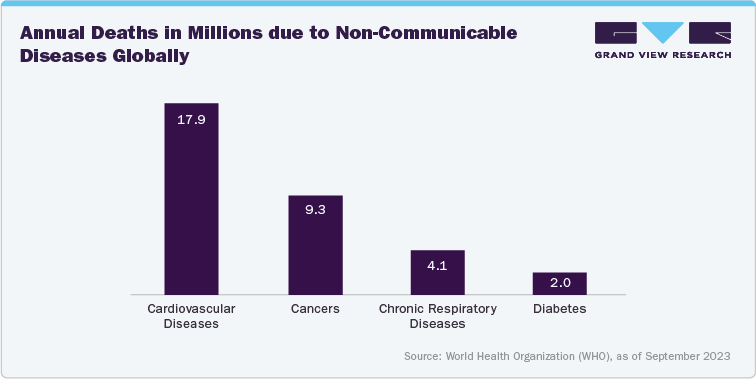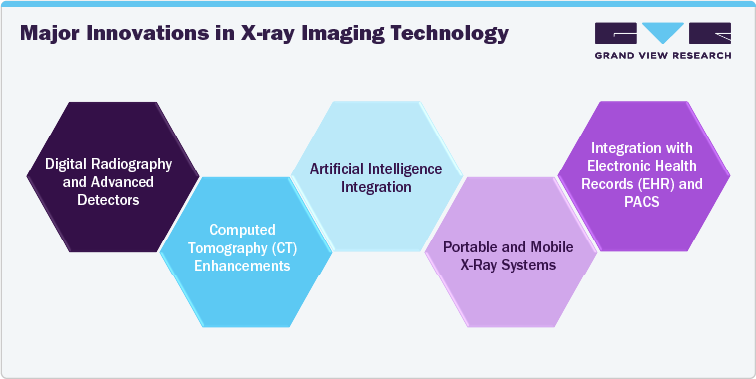- Home
- »
- Market Trend Reports
- »
-
Recent Development In X-Ray Imaging Technology
Overview Of The X-Ray Imaging Technology Industry
X-ray imaging technology in healthcare is a cornerstone of modern diagnostics, offering critical insights into the internal structures of the human body with minimal invasiveness. It encompasses various modalities, including traditional radiography, computed tomography (CT), mammography, and fluoroscopy. These technologies are essential for diagnosing and monitoring a broad spectrum of conditions, from fractures and infections to cancers and internal injuries. Advances in digital imaging have significantly improved image quality, reduced radiation doses, and streamlined workflows, making diagnostics more efficient and accurate. Integration with electronic health records (EHR) and picture archiving and communication systems (PACS) further enhances the management and accessibility of imaging data. Despite these advancements, the field continuously evolves to address challenges such as minimizing patient radiation exposure and adhering to stringent regulatory standards, ensuring that X-ray imaging remains a vital and safe tool in contemporary healthcare.
Market Dynamics And Growth Drivers
X-ray imaging technology has evolved significantly due to a complex interplay of drivers, including advances in technology, rising disease prevalence, regulatory frameworks, and government initiatives. The fundamental driver behind the widespread adoption and continuous enhancement of X-ray imaging is the growing demand for accurate and efficient diagnostic tools in healthcare. X-ray imaging remains a cornerstone in diagnostic medicine due to its ability to provide detailed internal images of the body quickly and non-invasively. This technology is crucial in diagnosing a wide array of conditions, from fractures and infections to more complex diseases such as cancers.
The rising incidence of chronic diseases and the aging population are major catalysts for the growth of X-ray imaging technology in healthcare. According to the World Health Organization (WHO), non-communicable diseases (NCDs) such as cardiovascular diseases, cancers, and respiratory conditions are responsible for approximately 71% of all global deaths. As these conditions often require detailed imaging for accurate diagnosis and monitoring, the demand for advanced X-ray systems has surged. Additionally, according to UN Department of Economic and Social Affairs, the aging population is projected to reach 1.5 billion people over the age of 65 by 2050, further drives the need for imaging technologies. Older individuals are more susceptible to conditions that necessitate regular imaging, such as osteoporosis and various cancers.

Technological advancements also play a pivotal role in the evolution of X-ray imaging. Innovations such as digital radiography (DR) and computed tomography (CT) have greatly improved image quality and diagnostic accuracy. For instance, in March 2022, Konica Minolta, Inc. announced the launch of the AeroDR TX m01, a mobile X-ray system with wireless dynamic digital radiography capabilities, in Japan. Digital radiography, for instance, replaces traditional film with digital detectors, resulting in quicker image acquisition and the ability to enhance and manipulate images for better diagnosis. CT scans, which provide cross-sectional images of the body, have revolutionized the way clinicians view and assess internal structures, allowing for more precise and comprehensive evaluations.
The regulatory environment significantly influences the development and deployment of X-ray technology. Regulatory bodies such as the U.S. Food and Drug Administration (FDA) and the European Medicines Agency (EMA) set stringent guidelines and standards to ensure the safety, efficacy, and quality of X-ray equipment. These regulations cover aspects from radiation safety and equipment performance to image quality and patient protection. The FDA, for instance, has established guidelines for the approval of new X-ray devices and monitors the safety of existing technologies through its post-market surveillance programs. Similarly, the International Electrotechnical Commission (IEC) provides international standards for X-ray equipment, ensuring consistency and safety across different regions.
Recent developments in X-ray technology are further driven by government initiatives and funding. Governments worldwide are investing in healthcare infrastructure, including advanced imaging technologies, to improve public health outcomes. For instance, the U.S. National Institutes of Health (NIH) and other government agencies fund research aimed at developing more efficient and less invasive imaging technologies. Initiatives such as the Health Information Technology for Economic and Clinical Health (HITECH) Act promote the adoption of electronic health records and advanced imaging technologies to enhance diagnostic capabilities and improve patient care. In May 2023, Carestream Health launched the DRX-Rise Mobile X-ray System, a comprehensive and fully integrated digital X-ray unit. This advanced system offers an economical option for customers looking to adopt digital imaging or to replace or expand their existing DR fleet without requiring a substantial capital investment.
Additionally, advancements in artificial intelligence (AI) are transforming X-ray imaging. AI algorithms are increasingly being integrated into imaging systems to assist radiologists in interpreting images more accurately and swiftly. AI can help identify subtle patterns and anomalies that might be missed by the human eye, thereby improving diagnostic accuracy and efficiency. For instance, AI-driven tools have shown promise in detecting early signs of diseases such as breast cancer and tuberculosis from X-ray images, potentially leading to earlier intervention and better outcomes. In December 2023, An AI-enhanced chest X-ray reporting solution commenced trials in NHS Greater Glasgow and Clyde, aiming to enhance the early detection of lung cancer.
Major Innovations In X-Ray Imaging Technology
-
Digital Radiography and Advanced Detectors: One of the most transformative innovations in X-ray technology is the shift from film-based systems to digital radiography (DR). DR systems use electronic sensors to capture images, which offers several advantages over traditional film-based systems, including faster image acquisition, improved image quality, and reduced radiation dose. Recent advancements in DR technology have introduced high-resolution flat-panel detectors and direct conversion sensors. Companies like Canon Medical Systems and Siemens Healthineers have developed advanced DR systems that incorporate these new detectors. For instance, Canon’s CXDI-710C and Siemens’ Ysio X.pree systems offer exceptional image clarity and faster processing times. These advancements reduce the need for repeat scans and improve diagnostic accuracy, particularly in complex cases such as trauma and cancer detection.
-
Computed Tomography (CT) Enhancements: CT imaging has also benefited from significant technological improvements. Recent innovations include the development of high-definition CT scanners and spectral CT imaging. These technologies provide enhanced resolution and the ability to differentiate between tissues with greater precision. Philips Healthcare’s Spectral CT, for instance, leverages dual-energy CT technology to capture images at multiple energy levels, allowing for better tissue characterization and more accurate disease detection. The ability to separate different types of tissues and contrast agents in a single scan has improved diagnostic capabilities, especially for conditions like tumors and vascular diseases.

-
Artificial Intelligence Integration: AI has become a game-changer in X-ray imaging, offering new possibilities for image analysis and interpretation. AI algorithms can assist radiologists by identifying patterns, highlighting abnormalities, and even predicting disease progression. These AI-driven tools help in enhancing diagnostic accuracy and efficiency. One notable example is the collaboration between Google Health and various healthcare institutions to develop AI models for detecting diabetic retinopathy and lung cancer from X-ray images. Google Health’s AI algorithms have demonstrated the ability to detect lung cancer with a higher accuracy rate compared to traditional methods. Similarly, Zebra Medical Vision’s AI algorithms are used for automated detection of a range of conditions, including fractures and pneumonia, which helps radiologists prioritize critical cases and streamline workflow. In October 2023, DeepTek.ai, India's leading medical imaging Artificial Intelligence (AI) Company, announced that it had received clearance from the US Food and Drug Administration (FDA) for its chest X-ray AI solution, the CXR Analyzer. This advanced technology utilizes deep learning algorithms to detect abnormalities in chest X-rays, automatically identifying, categorizing, and highlighting suspicious areas to assist clinicians in making accurate interpretations.
-
Portable and Mobile X-Ray Systems: The demand for portable and mobile X-ray systems has surged, driven by the need for flexible imaging solutions in various settings, including emergency rooms, intensive care units (ICUs), and remote locations. Recent developments in portable X-ray technology have made these systems more compact, lightweight, and capable of delivering high-quality images. Companies like GE Healthcare and Carestream Health have pioneered portable X-ray systems that combine advanced imaging technology with mobility. GE’s LOGIQ e and Carestream’s DRX-Revolution systems are examples of such innovations. These portable units provide high-resolution images and ease of use in bedside or field settings, enhancing diagnostic capabilities in situations where traditional imaging equipment is not feasible. For instance, in January 2024, Carestream Health introduced the upgraded DRX-Excel Plus X-ray System, which enhances the performance of this versatile two-in-one solution. The new system offers increased productivity and efficiency, superior image quality, and an improved experience for both users and patients.
-
Integration with Electronic Health Records (EHR) and PACS: The integration of X-ray imaging systems with electronic health records (EHR) and Picture Archiving and Communication Systems (PACS) has streamlined the management and accessibility of imaging data. This integration allows for seamless transfer of images and patient information, improving workflow efficiency and facilitating more comprehensive patient care. Companies like Agfa HealthCare and IBM Watson Health are leading the way in integrating X-ray imaging systems with EHR and PACS. This integration supports better coordination among healthcare providers, enables faster access to imaging results, and enhances the overall patient experience.
-
3D and 4D Imaging: Three-dimensional (3D) and four-dimensional (4D) imaging technologies are emerging as significant advancements in X-ray imaging. 3D imaging provides detailed volumetric views of anatomical structures, while 4D imaging adds the dimension of time, allowing for the visualization of dynamic processes. The development of 3D mammography (tomosynthesis) by companies like Hologic and Siemens has revolutionized breast cancer screening, providing clearer images and improving detection rates. Similarly, 4D imaging techniques are being explored for assessing dynamic processes such as blood flow and organ motion, enhancing diagnostic capabilities in various clinical scenarios.
Types of X-Ray Imaging Systems
- Digital Radiography (DR) Systems
Digital Radiography (DR) is a modern X-ray technology that replaces traditional film-based X-ray systems with digital detectors. DR systems capture X-ray images directly onto a digital sensor, providing high-quality images almost instantly.
- Computed Radiography (CR) Systems
Computed Radiography (CR) uses photostimulable phosphor (PSP) plates to capture X-ray images. After exposure, the plates are scanned by a CR reader to convert the captured image into a digital format.
- Fluoroscopy Systems
Fluoroscopy provides real-time imaging of the internal structures of the body using X-rays. It is often used for guiding diagnostic and therapeutic procedures.
- Mammography Systems
Mammography systems are specialized X-ray machines designed for breast imaging. They are used primarily for screening and diagnosing breast cancer.
- Chest X-Ray Systems
Specialized X-ray systems used primarily for imaging the chest, including the lungs, heart, and thoracic cavity.
Challenges in X-Ray Imaging Technology
-
Regulatory Compliance: The healthcare X-ray imaging industry is subject to stringent regulatory requirements to ensure safety and efficacy. Navigating complex regulations and obtaining necessary approvals can be challenging for companies, particularly when introducing new technologies or entering new markets.
-
Cost Pressures: The high cost of advanced X-ray systems can be a barrier to adoption, particularly in resource-limited settings. Balancing innovation with affordability is essential for addressing cost-related challenges and expanding market access.
-
Technological Complexity: As X-ray systems become more advanced, they also become more complex. Ensuring ease of use, minimizing technical issues, and integrating new technologies can be challenging for manufacturers and healthcare providers alike.
-
Data Security and Privacy: The integration of digital imaging systems with healthcare IT solutions raises concerns about data security and privacy. Protecting patient information and ensuring compliance with data protection regulations are critical for maintaining trust and ensuring the safe use of imaging technologies.
Competitive Scenario Of The X-Ray Imaging Technology Industry
The competitive scenario in the healthcare X-ray imaging technology industry is characterized by rapid technological advancements, significant competition among key players, and evolving market dynamics. Companies are continually innovating to improve image quality, reduce radiation exposure, and integrate new technologies. While the industry faces challenges related to regulatory compliance, cost pressures, and technological complexity, ongoing advancements and strategic initiatives are driving growth and shaping the future of healthcare imaging. The transition from analog to digital radiography has been a major trend in the healthcare X-ray market. DR systems offer improved image quality, faster processing times, and reduced radiation doses compared to traditional film-based systems. Innovations in DR technology focus on enhancing image resolution, optimizing dose management, and improving user interfaces. Leading companies in the healthcare X-ray imaging market invest heavily in research and development to stay competitive.
Innovations in imaging technology, AI integration, and workflow optimization are key areas of focus. Companies strive to develop advanced products that offer superior image quality, reduced radiation doses, and enhanced diagnostic capabilities. For instance, in August 2022, GE Healthcare introduced its most advanced fixed X-ray system, the next-generation Definium 656 HD. This new overhead tube suspension (OTS) system provides consistent, highly automated, and efficient exams that enhance clinical confidence. It also simplifies workflow, reduces errors, improves consistency, and helps radiology departments operate smoothly.
Collaborations and acquisitions are common strategies for expanding product offerings and market reach. Partnerships with healthcare providers, technology firms, and research institutions help companies leverage complementary technologies and enter new markets. For instance, in April 2024, Shimadzu Medical Systems USA (SMS), a division of Shimadzu Precision Instruments, Inc., which is a subsidiary of Shimadzu Corporation Japan, acquired California X-ray Imaging Services, Inc. (CIS) to expand its healthcare business in North America further. Similarly, in March 2021, Philips announced partnership with Lunit, a leading medical AI startup. Through this collaboration Lunit’s INSIGHT CXR chest detection suite will be incorporated into Philips diagnostic X-ray suite, to achieve better patient outcomes, improving the experience of patients and staff, and lower the cost of care.
Expanding into emerging markets with growing healthcare infrastructure is a strategic focus for many companies. Geographic expansion allows companies to tap into new revenue streams and address the increasing demand for advanced imaging solutions in developing regions. For instance, in October 2023, Carestream Health announced a partnership with EXAMION, a prominent provider of medical imaging solutions in Germany. This collaboration reinforces Carestream’s dedication to offer healthcare organizations across Germany and Europe advanced diagnostic imaging solutions. The partnership aims to enhance user and patient experiences, improve clinical outcomes, and streamline radiography workflows.
Share this report with your colleague or friend.
GET A FREE SAMPLE
This FREE sample includes market data points, ranging from trend analyses to market estimates & forecasts. See for yourself.
![gvr icn]()
NEED A CUSTOM REPORT?
We can customize every report - free of charge - including purchasing stand-alone sections or country-level reports, as well as offer affordable discounts for start-ups & universities.
Contact us now to get our best pricing.
![esomar icon]()
ESOMAR certified & member
![ISO]()
ISO Certified
We are GDPR and CCPA compliant! Your transaction & personal information is safe and secure. For more details, please read our privacy policy.
-
We are committed towards customer satisfaction, and quality service.
Client Testimonials

"The quality of research they have done for us has been excellent..."
ISO Certified


